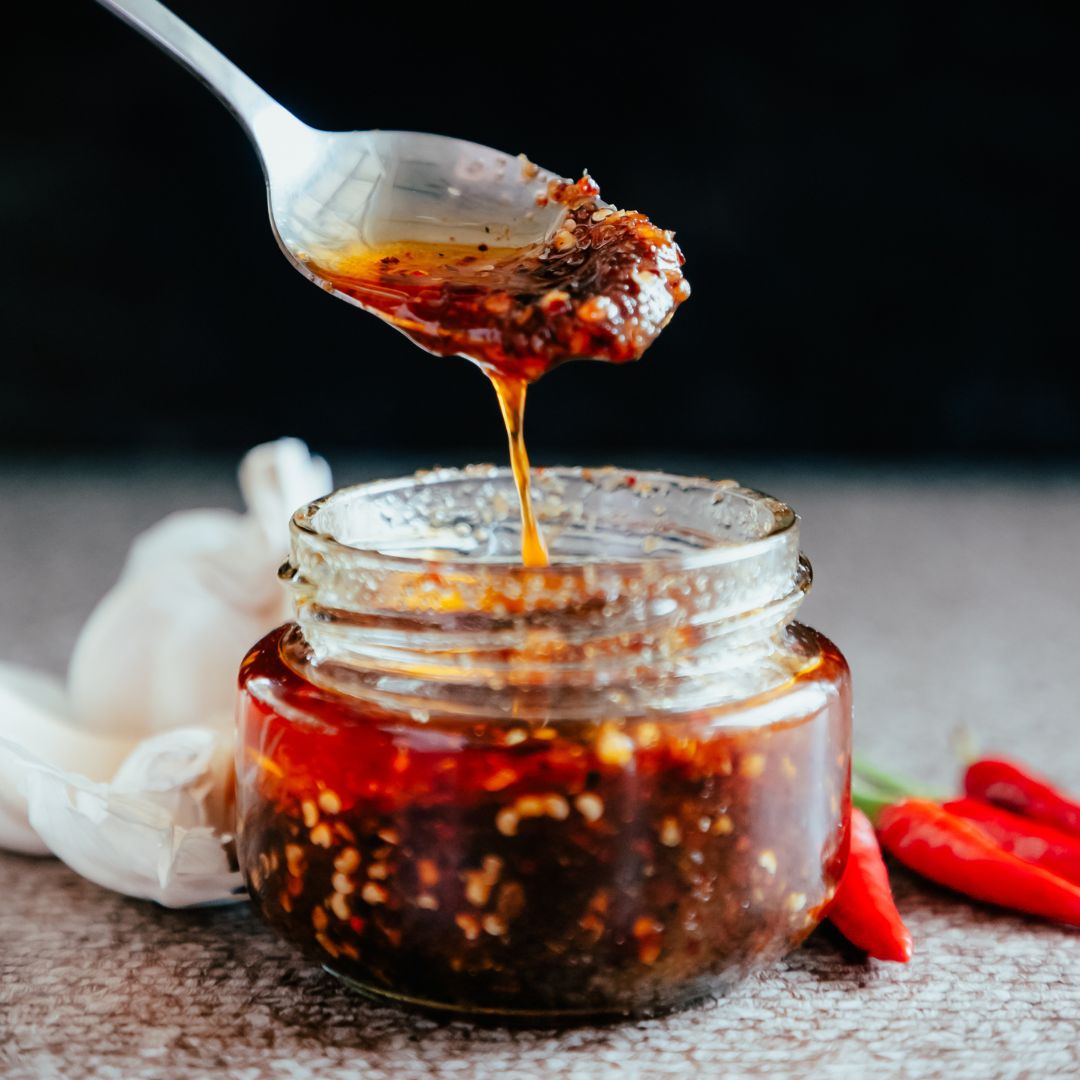
Chili Oil: Benefits, Uses, and Recipes
Chili oil, a vibrant and flavorful condiment, has been a staple in many cuisines around the world. Made by infusing oil with chili peppers, it adds a spicy kick to dishes while offering numerous health benefits. In this comprehensive guide, we will explore everything you need to know about chili oil, including its nutritional profile, health benefits, culinary uses, and some delicious recipes to try at home.

What is Chili Oil?
Chili oil is a condiment created by infusing various oils—such as vegetable oil, olive oil, or sesame oil—with dried chili peppers and sometimes additional spices or aromatics like garlic or ginger. This infusion process allows the oil to absorb the flavors and heat of the chilies, resulting in a rich and spicy product that enhances the taste of many dishes.
Nutritional Profile of Chili Oil
Chili oil is not just about flavor; it also contains several beneficial compounds:
- Capsaicin: The active component in chili peppers that gives them their heat. Capsaicin is known for its anti-inflammatory and metabolism-boosting properties.
- Vitamins: Chili oil is rich in vitamin C and other antioxidants that help protect cells from damage.
- Healthy Fats: Depending on the type of oil used for infusion (like olive or avocado oil), chili oil can provide healthy monounsaturated fats.
Health Benefits of Chili Oil
1. Improved Heart Health
Chili oil contains capsaicin, which has been shown to improve blood circulation and reduce inflammation. Regular consumption may lower blood pressure and decrease the risk of heart disease by promoting better cardiovascular health.
2. Weight Loss Support
The capsaicin in chili oil can boost metabolism, helping the body burn calories more efficiently. It may also reduce appetite, making it easier for individuals to manage their weight.
3. Pain Relief
Capsaicin is known for its analgesic properties. It can help alleviate pain by desensitizing nerve receptors responsible for sending pain signals to the brain. This makes chili oil a potential remedy for conditions like arthritis and muscle soreness.
4. Enhanced Digestion
Chili oil can stimulate the production of digestive juices, which aids in digestion and may help prevent issues like bloating and gas. Additionally, it may protect against harmful bacteria that can lead to stomach ulcers.
5. Boosted Immunity
Rich in antioxidants like vitamin C, chili oil can strengthen the immune system by protecting cells from oxidative stress and enhancing the body’s natural defenses against infections.
6. Anti-Inflammatory Effects
The anti-inflammatory properties of capsaicin can help reduce inflammation throughout the body, potentially alleviating symptoms associated with chronic inflammatory conditions.
7. Mood Enhancement
Consuming spicy foods like chili oil can trigger the release of endorphins, which are hormones that promote feelings of happiness and well-being.
Culinary Uses of Chili Oil
Chili oil is incredibly versatile and can be used in various culinary applications:
- Drizzling: Use it as a finishing touch on pizzas, pasta dishes, or grilled vegetables.
- Dipping Sauce: Combine with soy sauce or vinegar for a spicy dipping sauce for dumplings or spring rolls.
- Marinades: Incorporate into marinades for meats or tofu to add flavor and heat.
- Stir-Fries: Use it in stir-frying vegetables or proteins for an extra kick.
- Soups: Add a splash to soups or broths to enhance flavor.
How to Make Homemade Chili Oil
Making your own chili oil at home is simple and allows you to customize the flavor:
Ingredients:
- 1 cup of neutral oil (like vegetable or grapeseed)
- 1/4 cup dried chili flakes (adjust based on desired heat)
- Optional: garlic cloves, ginger slices, or spices like star anise
Instructions:
- Heat the Oil: In a small saucepan over low heat, warm the oil until it reaches about 200°F (93°C). Do not let it smoke.
- Add Ingredients: Add dried chili flakes (and any optional ingredients) to the warm oil.
- Infuse: Let the mixture simmer gently for about 10-15 minutes. Remove from heat when fragrant but be careful not to burn the chilies.
- Cool and Strain: Allow the oil to cool completely before straining it into a clean bottle.
- Store: Store in a cool, dark place for up to a month.
Delicious Recipes Featuring Chili Oil
Spicy Garlic Noodles
Ingredients:
- 8 oz noodles (your choice)
- 2 tablespoons chili oil
- 4 cloves garlic, minced
- 2 tablespoons soy sauce
- 1 tablespoon sesame seeds
- Green onions for garnish
Instructions:
- Cook noodles according to package instructions; drain.
- In a pan, heat chili oil over medium heat; add minced garlic and sauté until fragrant.
- Add cooked noodles and soy sauce; toss well.
- Top with sesame seeds and green onions before serving.
Chili Oil Roasted Vegetables
Ingredients:
- 2 cups mixed vegetables (bell peppers, zucchini, carrots)
- 2 tablespoons chili oil
- Salt and pepper to taste
Instructions:
- Preheat oven to 425°F (220°C).
- Toss vegetables with chili oil, salt, and pepper.
- Spread on a baking sheet and roast for 20 minutes or until tender.
Potential Risks of Chili Oil
While chili oil offers numerous benefits, there are some considerations:
- Digestive Discomfort: For some individuals, consuming too much spicy food can lead to digestive issues such as heartburn or upset stomach.
- Allergic Reactions: Those with allergies to specific spices should exercise caution.
- Moderation is Key: It’s best consumed in moderation—typically one to two teaspoons per day—to avoid potential adverse effects.
FAQs
What is chili oil made from?
Chili oil is made by infusing various oils (such as vegetables or olives) with dried chili peppers along with optional spices like garlic or ginger.
What are the health benefits of chili oil?
Chili oil offers several health benefits including improved heart health, weight loss support, pain relief, enhanced digestion, boosted immunity, anti-inflammatory effects, and mood enhancement.
How should I use chili oil in cooking?
Chili oil can be used as a drizzle on dishes, in marinades, as part of dipping sauces, in stir-fries, or simply added to soups for extra flavor.
Is homemade chili oil better than store-bought?
Homemade chili oil allows for customization regarding spice level and flavor profile while ensuring freshness without preservatives found in some store-bought varieties.
Are there any risks associated with consuming chili oil?
Excessive consumption may lead to digestive discomfort for some individuals; therefore moderation is key when incorporating it into your diet.
Conclusion
Chili oil is more than just a flavorful condiment; it’s packed with health benefits ranging from improved heart health to enhanced digestion. Its versatility in cooking makes it an excellent addition to various dishes while providing a spicy kick that many enjoy. Whether you choose to buy it from stores or make your own at home, incorporating chili oil into your diet can be both delicious and beneficial.
